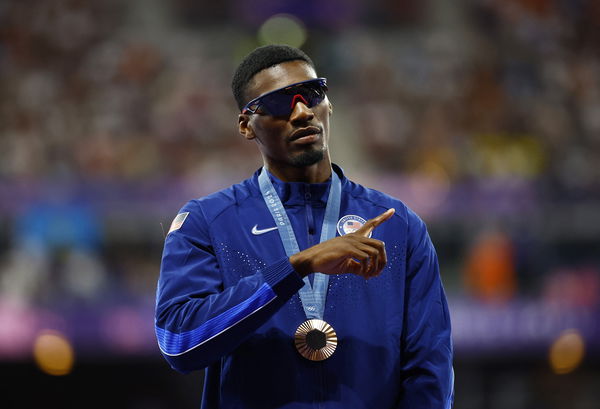
via Reuters
Paris 2024 Olympics – Athletics – Men’s 100m Victory Ceremony – Stade de France, Saint-Denis, France – August 05, 2024. Bronze medallist Fred Kerley of United States celebrates on the podium. REUTERS/Sarah Meyssonnier

via Reuters
Paris 2024 Olympics – Athletics – Men’s 100m Victory Ceremony – Stade de France, Saint-Denis, France – August 05, 2024. Bronze medallist Fred Kerley of United States celebrates on the podium. REUTERS/Sarah Meyssonnier
Fred Kerley, the Olympic silver medalist from Tokyo 2020 and bronze medalist at the 2024 Games in the 100m, is shaking things up in track and field. The American sprinting star, who also snagged 100m gold at the 2022 World Championships, has joined Michael Johnson’s new Grand Slam Track (GST) league. And he’s not holding back on why. With a career that boasts six World Championship medals and a personal best of 9.76 seconds in the 100m—making him the sixth-fastest man ever—Kerley’s move to GST is a bold statement. But what’s driving this track titan to take on a new challenge?
At the Grand Slam Track event in Kingston on April 4, 2025, a striking image captured Kerley’s no-nonsense vibe. Posted by FloTrack on X, Fred was asked, ‘Why were you willing to go in so early?’ and ‘Why were you calling the shot like that?’
Fred was direct, ‘to GET PAID.” The video shows him seated, staring intently, with the caption overlaying his blunt two-word reason: “GET PAID.” The backdrop of the event, marked with “GRAND SLAM TRACK” and “drip,” sets the stage for a high-stakes showdown. Kerley’s words cut straight to the point. This signals his intent to secure the bag at GST’s Kingston Slam. Now that’s where over a million dollars in prize money is up for grabs. So, what’s behind this unapologetic stance?
ADVERTISEMENT
Article continues below this ad
Plain and simple: @fkerley99 is in Kingston to secure the bag 💼#GSTKingston pic.twitter.com/YBvkomXHGn
— FloTrack (@FloTrack) April 4, 2025
Clearly, Kerley’s “GET PAID” declaration reflects a deeper frustration with the current track and field ecosystem. To put things into perspective, his accolades include an Olympic silver in 2020 with a 9.84-second 100m and a 400m personal best of 43.64 seconds. In fact, this ranks him the tenth-fastest man in history for that event. Nevertheless, the financial rewards in track often don’t match the grind. Despite the effort and excellence, athletes like Kerley continue to face a system that undervalues their contributions.
Earlier, Gabby Thomas also voiced a similar concern: “The Grand Slam track initiative seeks to provide a continuous platform for athletes to compete, ensuring that fans have regular events to follow. This helps sustain interest in the sport.”Grand Slam Track, with its promise of big payouts and head-to-head competition, seems to be the answer Kerley’s been looking for. But how does this move fit into the broader landscape of the sport?
ADVERTISEMENT
Article continues below this ad
Exploring the financial model and incentives offered in GST
Grand Slam Track (GST) is flipping the script on track and field’s financial game. And fans are here for it. Founded by Olympic icon Michael Johnson, GST guarantees its athletes a base compensation. The prize money ranges from $10,000 for eighth place to a hefty $100,000 for first. And that’s at each of its four annual Slams. Just like the one in Kingston on April 4, 2025.
What’s your perspective on:
Is Fred Kerley right to prioritize 'GET PAID' over traditional track glory? What's your take?
Have an interesting take?
According to Sports Business Journal, the league is set to distribute $12.6 million in prize money in its debut 2025 season. Now, that’s a massive leap compared to the Diamond League’s $9.24 million in 2024. Additionally, Johnson shared on CNBC that athletes who are injured and can’t compete still get their full base pay. “GET PAID”—a two-word mantra Fred Kerley dropped at the Kingston event—feels like the perfect fit for GST’s model. But how does this compare to other major sports?
ADVERTISEMENT
Article continues below this ad

via Reuters
Paris 2024 Olympics – Athletics – Men’s 100m Final – Stade de France, Saint-Denis, France – August 04, 2024. Fred Kerley of United States celebrates after winning bronze. REUTERS/Dylan Martinez
For fans, GST’s financial model feels like a breath of fresh air compared to the traditional track setup. The Diamond League pays $7,000 for third place. On the other hand, GST offers $30,000 for the same spot, and second place gets $50,000 compared to the Diamond League’s $12,000. Plus, GST ensures athletes are guaranteed spots in all four events if they’re healthy. This gives stars like Kerley a consistent shot at big earnings—potentially up to $400,000 a season if they dominate. It’s a structure that mirrors tennis’ Grand Slams. That’s also what Johnson has cited as inspiration. A structure where top players can earn millions. Just like the $6 million winner’s prize at the Six Kings Slam in 2024. With $30 million already raised for the league, GST is clearly aiming to rival those sports—but can it sustain this momentum long-term?
ADVERTISEMENT
ADVERTISEMENT
ADVERTISEMENT
ADVERTISEMENT


Is Fred Kerley right to prioritize 'GET PAID' over traditional track glory? What's your take?